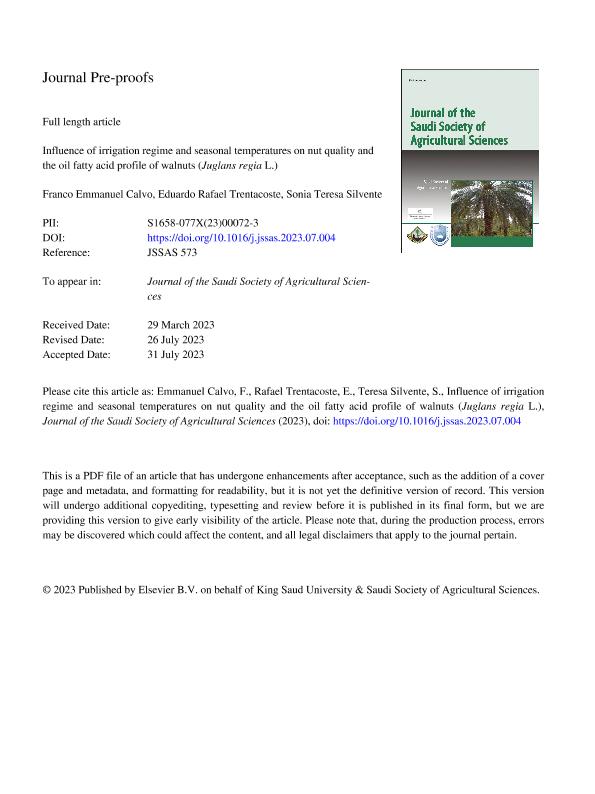Mostrar el registro sencillo del ítem
dc.contributor.author
Calvo, Franco Emmanuel

dc.contributor.author
Trentacoste, Eduardo Rafael
dc.contributor.author
Silvente, Sonia Teresa

dc.date.available
2023-12-15T15:51:00Z
dc.date.issued
2023-08
dc.identifier.citation
Calvo, Franco Emmanuel; Trentacoste, Eduardo Rafael; Silvente, Sonia Teresa; Influence of irrigation regime and seasonal temperatures on nut quality and the oil fatty acid profile of walnuts (Juglans regia L.); Elsevier; Journal of the Saudi Society of Agricultural Sciences; 2023; 8-2023; 1-20
dc.identifier.issn
1658-077X
dc.identifier.uri
http://hdl.handle.net/11336/220450
dc.description.abstract
Walnut production is expanding worldwide due to the high demand for natural products with proven nutraceutical properties. This expansion includes new growing areas, such as central–western Argentina, where crop water requirements have yet to be determined and little is known about the response in terms of production quality to the water regime. The aim of this study was to assess the effects of four irrigation regimes (at 50, 75, 100, and 125 % of crop evapotranspiration) and the weather conditions over two consecutive seasons in a young Chandler walnut orchard in terms of in–shell and kernel caliber, kernel color, oil concentration, and fatty acid profile. Quality production characteristics were not significantly affected by irrigation regimes within each season. In contrast, the quality parameters achieved were significantly different between seasons. The first season (S1) was wetter (462 mm) and cooler (17.05 °C mean air temperature in the oil accumulation period) and produced more extra–light kernels (92%). The second season (S2) was drier (326 mm) and warmer (19.02 °C) and produced a lower proportion of extra–light kernels (82.2%). In addition, during the second season, walnuts produced larger kernels with a higher oil concentration (62.7%; +3.5% of S1) and a better omega–6/omega–3 ratio (3.25 in S2 vs. 3.70 in S1). These results suggest that kernel quality was more sensitive to the seasonal temperature than the irrigation studied regimes. The nutritional quality of walnuts may increase significantly in warmer seasons/environments despite the deterioration of kernel color.
dc.format
application/pdf
dc.language.iso
eng
dc.publisher
Elsevier

dc.rights
info:eu-repo/semantics/openAccess
dc.rights.uri
https://creativecommons.org/licenses/by-nc-sa/2.5/ar/
dc.subject
ARGENTINA
dc.subject
CHANDLER
dc.subject
KERNEL COLOR
dc.subject
LINOLENIC ACID
dc.subject
OMEGA–6/OMEGA–3 RATIO
dc.subject
WATER DEFICIT
dc.subject.classification
Agricultura

dc.subject.classification
Agricultura, Silvicultura y Pesca

dc.subject.classification
CIENCIAS AGRÍCOLAS

dc.title
Influence of irrigation regime and seasonal temperatures on nut quality and the oil fatty acid profile of walnuts (Juglans regia L.)
dc.type
info:eu-repo/semantics/article
dc.type
info:ar-repo/semantics/artículo
dc.type
info:eu-repo/semantics/publishedVersion
dc.date.updated
2023-12-12T15:44:04Z
dc.journal.volume
2023
dc.journal.pagination
1-20
dc.journal.pais
Países Bajos

dc.journal.ciudad
Amsterdam
dc.description.fil
Fil: Calvo, Franco Emmanuel. Consejo Nacional de Investigaciones Científicas y Técnicas; Argentina. Universidad Nacional de Chilecito; Argentina
dc.description.fil
Fil: Trentacoste, Eduardo Rafael. Instituto Nacional de Tecnología Agropecuaria. Centro Regional Mendoza-San Juan. Estación Experimental Agropecuaria La Consulta; Argentina
dc.description.fil
Fil: Silvente, Sonia Teresa. Universidad Nacional de Chilecito. Departamento de Ciencias Basicas y Tecnologicas; Argentina
dc.journal.title
Journal of the Saudi Society of Agricultural Sciences
dc.relation.alternativeid
info:eu-repo/semantics/altIdentifier/url/https://linkinghub.elsevier.com/retrieve/pii/S1658077X23000723
dc.relation.alternativeid
info:eu-repo/semantics/altIdentifier/doi/http://dx.doi.org/10.1016/j.jssas.2023.07.004
Archivos asociados
